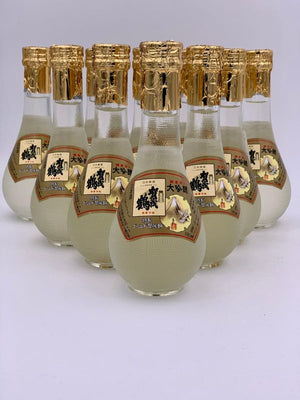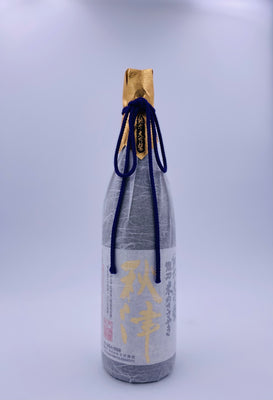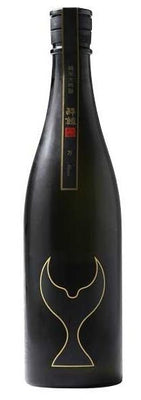
A Sake we have only been able to offer once before, we are receiving a new shipment from our supplier next week of the most current batch of the Myouka Rangyoku from Daishichi. Daishichi was founded in 1752 and is known for its incredible Kimoto Style Sakes. Their Myoka Rangyoku is one of their "grand cru" bottlings, as they call it. It comes from free-run, undiluted Junmai Daiginjo brewed using the traditional Kimoto method. This Sake took almost a decade to master, producing only 158 bottles in its first year in 1989. It was also the first Kimoto-style sake to win a gold medal at Japan's National Competition of New Sake. There is exceptional quality control for the Myouka Rangyoku, and every grain of rice is hand-selected, much like at Chateau d'Yquem when harvesting botrytized grapes one by one. Striving to do even better, Daishichi developed a revolutionary rice polishing technique called "super flat rice polishing." This method helped Daishichi get the ideal balance of polished rice for their Sake while pushing the envelope of quality, polishing it in the shape of an oval as opposed to a circle. When we met the ambassadors at a tasting, they mentioned this technique preserves more of the umami core of the rice, whereas, in a traditional polishing method, more is lost. Many producers look to a high polished rice ratio to justify the price of their Sake, but Daishichi's only intention is to make the best Sake possible. Nature provides the natural yeasts for fermentation and the complex working of micro-organisms that influence the flavors. Because of the stress that the Kimoto-style fermentation puts on the yeast, only a handful of the most powerful survive. The maturation of this Sake lasts over one year, which is comparable to keeping wine on its fine lees for an extended period where it ages and integrates. Afterward, the bottles are "cellared" for four more years. The result is an intense and powerful sake that does not lose sight of purity or balance with notes of melon, herbs, steamed rice, minerality, and white flowers. The palate is powerful, ending with an explosive finish, and yet it is one of the most elegant Kimoto-style sakes we have tried. Registering slightly sweeter than some of the other Sakes we have offered, this has the acidity to keep it in check and pairs better with Sashimi than it does Sushi. Myoka Rangyoku would also hold up to some fattier beef, but our favorite pairing is Yellowtail Belly Sashimi. An exceptional bottle of Sake showing off the power, elegance, and nuances as one of the pinnacle expressions of traditional Kimoto Style Sake.
Daishichi Myouka Rangyoku JDGJ 720ml
Daishichi Myouka Rangyoku JDGJ 720ml
A Sake we have only been able to offer once before, we are receiving a new shipment from our supplier next week of the most current batch of the Myouka Rangyoku from Daishichi. Daishichi was founded in 1752 and is known for its incredible Kimoto Style Sakes. Their Myoka Rangyoku is one of their "grand cru" bottlings, as they call it. It comes from free-run, undiluted Junmai Daiginjo brewed using the traditional Kimoto method. This Sake took almost a decade to master, producing only 158 bottles in its first year in 1989. It was also the first Kimoto-style sake to win a gold medal at Japan's National Competition of New Sake. There is exceptional quality control for the Myouka Rangyoku, and every grain of rice is hand-selected, much like at Chateau d'Yquem when harvesting botrytized grapes one by one. Striving to do even better, Daishichi developed a revolutionary rice polishing technique called "super flat rice polishing." This method helped Daishichi get the ideal balance of polished rice for their Sake while pushing the envelope of quality, polishing it in the shape of an oval as opposed to a circle. When we met the ambassadors at a tasting, they mentioned this technique preserves more of the umami core of the rice, whereas, in a traditional polishing method, more is lost. Many producers look to a high polished rice ratio to justify the price of their Sake, but Daishichi's only intention is to make the best Sake possible. Nature provides the natural yeasts for fermentation and the complex working of micro-organisms that influence the flavors. Because of the stress that the Kimoto-style fermentation puts on the yeast, only a handful of the most powerful survive. The maturation of this Sake lasts over one year, which is comparable to keeping wine on its fine lees for an extended period where it ages and integrates. Afterward, the bottles are "cellared" for four more years. The result is an intense and powerful sake that does not lose sight of purity or balance with notes of melon, herbs, steamed rice, minerality, and white flowers. The palate is powerful, ending with an explosive finish, and yet it is one of the most elegant Kimoto-style sakes we have tried. Registering slightly sweeter than some of the other Sakes we have offered, this has the acidity to keep it in check and pairs better with Sashimi than it does Sushi. Myoka Rangyoku would also hold up to some fattier beef, but our favorite pairing is Yellowtail Belly Sashimi. An exceptional bottle of Sake showing off the power, elegance, and nuances as one of the pinnacle expressions of traditional Kimoto Style Sake.






